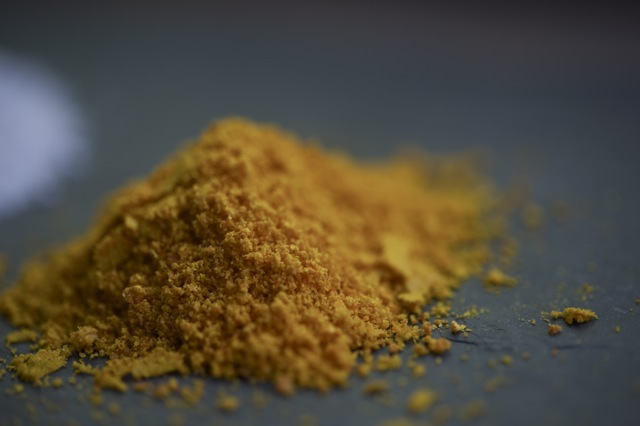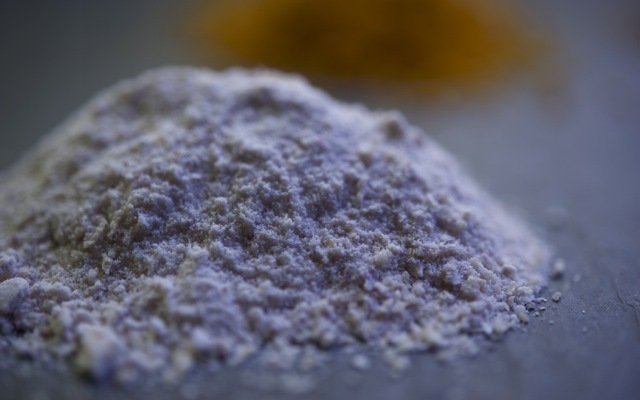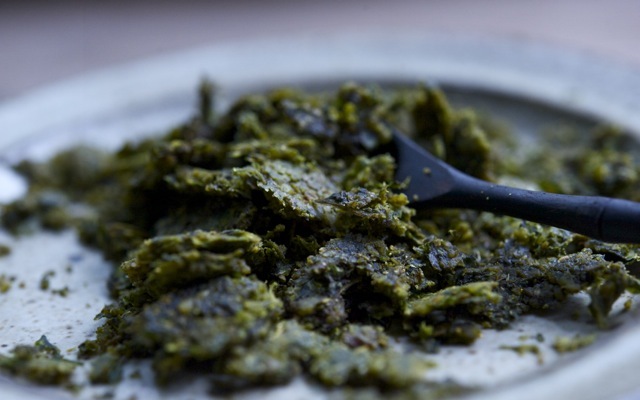10.4.12 Dust to Dust

photos by gluttonforlife
The trickle-down effect—that notion that high culture eventually makes its way to the masses—is news to none of us, and we've also seen the innovations of the street appropriated by the upper echelons. (The high-low mix is basically something of a cliché at this point.) So it will come as no suprise to you that I've recently been experimenting at home with a phenomenon that originated in the most rarefied kitchens. I've witnessed how even highly creative chefs shamelessly borrow from each other, so I'm not worried that you'll find me pathetically derivative. Take, for instance, that frozen foie gras that David Chang shaves over lychees and pine nuts at Momofuku Ko. Before that, René Redzepi at Noma in Copenhagen was shaving frozen sea urchin over a dish of tiny shrimp and foraged beach mustard. I believe Redzepi was the one who started this whole phenomenon of powders and dusts, serving up reindeer lichen dusted with mushroom powder, and a terrine of baby vegetables covered with a powdered malt "dirt." It's part of Noma's whole ethos of preserving, preserving, preserving—storing up an arsenal of flavors to get through those long Nordic winters. Once you wrap your mind around the idea that you can dehydrate almost anything, then grind or crumble it into a very versatile medium, I think you may jump on this culinary bandwagon (along with the rest of the world).

peel out
For me, it started last year when I had a surplus of black trumpet mushrooms and dried many of them, some of which I used to make a fine powder. Its concentration of flavor (and aroma!) was pretty amazing and I found myself dusting it around liberally, on its own and mixed with salt. A few weeks ago, when my friends at Best Made asked me to play around with a wonderful hand-harvested Oregon sea salt they've just started selling, I decided to blend it with some other flavors for a kind of updated seasoned salt. Remember Lawry's?

daily rind
I use my dehydrator to relieve all manner of fruits and vegetables of their liquid content, but you can also slow-dry things in your oven. You don't want the temperature much above 150 degrees, so if your oven won't go that low, experiment with propping the door open. (I use a wooden spoon, but G says I probably shouldn't endorse that in a public forum.) The intensely orange stuff, above, is dried orange peel, ground into a fine powder in my spice grinder (really just a repurposed coffee grinder). This on its own is wonderful stirred into tomato sauce, sprinkled over ice cream or goat cheese, or added to tea, among so many other uses.

take a powder
Thinly sliced shallots, dried and pulverized, retain a lovely lavender hue. Shallots are a bit milder and sweeter than onions, which also work well. It's pretty much impossible to go back to mass onion or garlic powder once you've made your own. The difference in flavor is truly remarkable.

sweet and dry
This is granulated honey, which I actually bought at Kalustyan's. I was intrigued by the sound of it and brought some home without any firm notion of how I would use it. It has a pleasing gritty texture and the round sweetness you would expect. I mixed this, along with the powdered orange peel and shallot and some aromatic piment d'Espelette into the flaky sea salt and pounded it all together just a bit in my mortar and pestle. The result was an exceptionally tasty blend of salty, sweet and savory with a slightly sandy texture. I could not stop myself from sprinkling it over everything, including my oatmeal. I blended it into lamb burgers and rubbed it into tofu. Truly addictive. I pass this idea onto you as a sort of gateway project into the world of powders and crumbles. I'm hoping you will get drunk on the possibilities.

cut and dried
Take this pesto crumble, for instance. It's an excellent way to preserve all that basil that's coming to an end in your garden, but much more versatile than containers of frozen pesto. It substitutes nutritional yeast (another recent obsession of mine) for cheese and keeps indefinitely in an airtight container. I sprinkled mine over pasta and salads, tucked it into a grilled tomato sandwich and baked it on top of a squash gratin, all with stellar results. If your ingredients have retained any moisture before you grind or crumble them up, you'll find they have a slightly denser texture and may clump together more than you want. Think of your kitchen as a lab and experiment. Now think of yourself as a mad scientist. Now get to work.
Basil Crumble
makes about 3/4 cup
- — 1 1/2 packed cups fresh basil leaves (remove all horsey stems)
- — 1/3 cup pine nuts (preferably not the Chinese kind)
- — 2 tablespoons fresh lemon juice
- — 1 tablespoon onion powder (preferably homemade)
- — 1 tablespoon nutritional yeast
- — 1/2 teaspoon sea salt
Combine all the ingredients in your food processor and whizz into a smooth paste.
Spread this paste on a parchment or Silpat-lined baking sheet, or a dehydrator sheet, and dry in a low oven or dehydrator set to 145-150 degrees until very dry and crisp.
Crumble into a chunky texture. Store in an airtight container.
 Download Recipe
Download Recipe






4 Comments